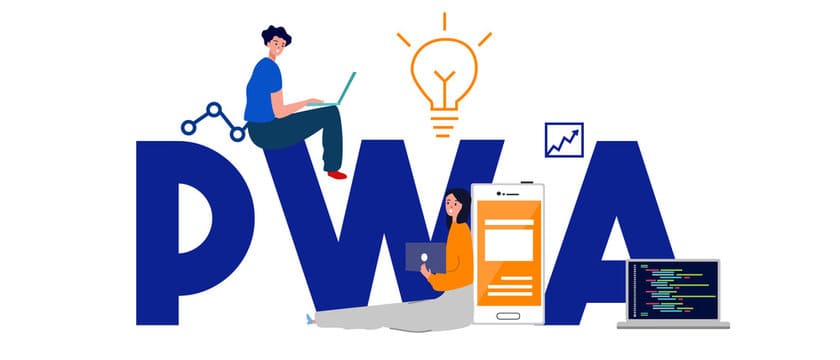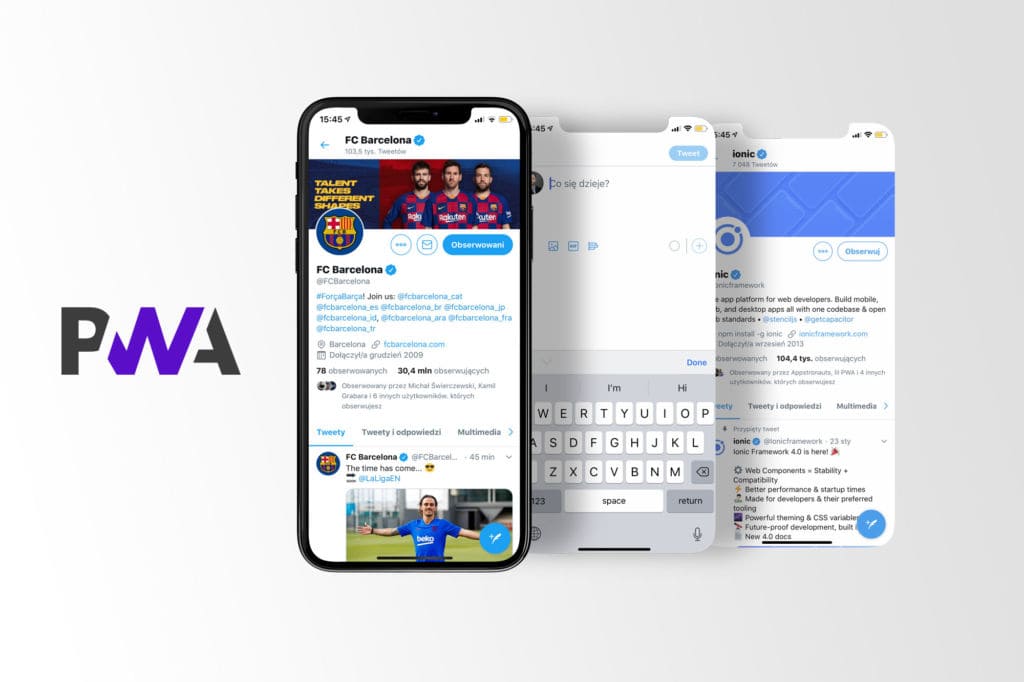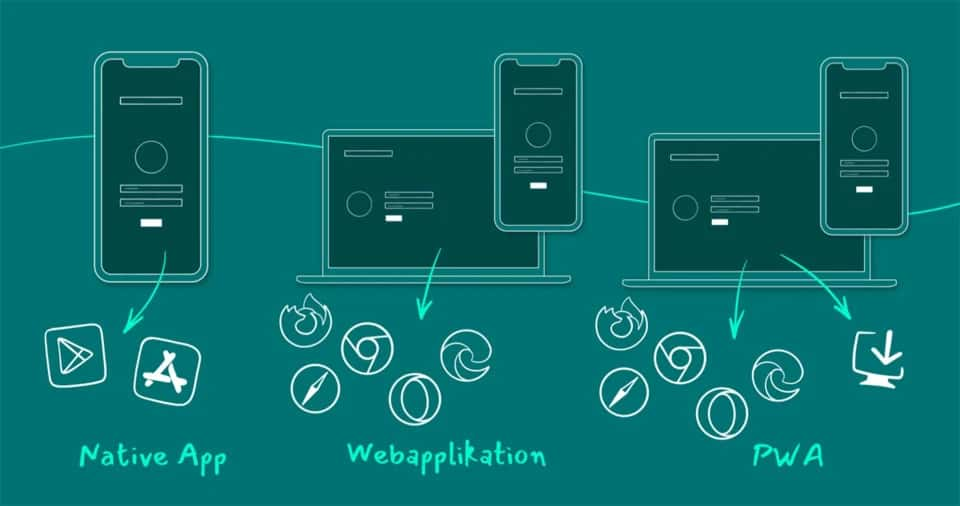The APAC web landscape faces a unique challenge: Diverse connectivity across the region leaves 60% of APAC mobile users frustrated with slow loading times. Businesses struggle to deliver seamless digital experiences when internet speeds vary from blazing-fast fiber to unreliable mobile networks.
PWAs, or Progressive Web Apps for the uninitiated, pop up as the solution. These cool tools bridge the web app gap, offering lightning-fast loading on slow connections and offline functionality for uninterrupted access. Plus, PWAs deliver an app-like experience with features like push notifications and home screen installation, all without app store downloads.
So, how do PWAs can revolutionize your digital game in APAC?
Table of Contents
PWAs Vs. Native Apps: What Are PWAs?
While they might look similar at first glance, Progressive Web Apps (PWAs) offer a strong leap forward compared to traditional web apps. PWAs are built for the modern web, leveraging features and functionalities specifically suited for the APAC mobile landscape. Unlike a single technology, PWAs combine various modern web APIs and best practices. Basically, any website that meets three core criteria (service worker registration, HTTPS security, and a web app manifest file) can be considered a PWA.
These core elements unlock a bunch of powerful benefits, as we’ll explore in the following sections. This focus on core functionalities and user experience makes PWAs a convincing solution for businesses in the APAC region, as they bridge the gap between websites and mobile apps:
- Reach of a Website: Accessible through any web browser on any device, just like a website.
- Engagement of an App: Provides a fast, immersive experience with features like push notifications and home screen installation, similar to native apps.
In the PWAs vs. native apps query, PWAs are the obvious choice for businesses in APAC. According to our Vinovators, when it comes to web apps, PWAs offer too many benefits compared to traditional web apps, such as leveraging modern web technologies, making them a strong tool for businesses to reach users across diverse platforms.
The APAC Regions Challenges: Why Should You Embrace PWAs’
The diverse connectivity landscape of the region presents a tough situation:
- Fragmentation: APAC comprises nations at different stages of digital development. Not much net: In the Asia-Pacific region, the ratio stands at 1.5, indicating that urban areas still have significantly higher internet access than rural areas. Businesses aiming for a regional audience face challenges reaching users with spotty connections and inconsistent internet experiences.
- Limited Internet Access: Patchy connections and limited data plans lead to snail-paced loading times for traditional websites in APAC. Slow loading times translate to annoyed folks, increased bounce rates, and ultimately, missed sales. Research shows that even a 100-millisecond delay in website load time can result in a 7% increase in bounce rates.
- App Fatigue: App fatigue is a big worry as users become overwhelmed by the sheer number of mobile apps. On average, 9,406 Android apps and 5,835 iOS apps were published in the Google Play Store and the Apple App Store respectively each week. Additionally, discovering new apps within app stores can be difficult. Businesses struggle to stick out in crowded app stores, and users might be hesitant to download new apps due to data limitations.
4 Outstanding PWAs’ Benefits And Powerful Features:

Progressive Web Apps (PWAs) offer the best of both worlds: web accessibility and app-like functionality. This unique blend is achieved through several key features that enhance user experience and drive engagement, as evidenced by real-world success stories:
- Seamless Across Devices (Responsive Design): PWAs boast responsive design, seamlessly adapting to various screen sizes from desktops to mobile devices. Users experience a consistent and user-friendly interface regardless of the platform they access the PWA from.
Twitter Lite, a PWA by Twitter, expanded its user base in areas with limited internet access thanks to its responsive design. This ensures a smooth experience on any device, even with lower-powered hardware.
- App-like Navigation & Engagement (Smooth Animations, Intuitive Navigation): PWAs provide a smooth, app-like experience with features like swipe gestures and minimal page reloads. This mimics the familiar feel of native apps, getting people involved and interacting.
Starbucks’ PWA improved mobile ordering by offering faster loading times and increased user engagement. The intuitive navigation and smooth animations create a seamless experience that mirrors native apps, encouraging users to interact more readily.
- Offline Web Experiences: One of the most powerful features of PWAs is their ability to work offline. PWAs cache essential resources during the first visit, allowing users to access content even when they’re not connected to the internet. This is especially crucial in regions with unreliable connectivity or during network outages.
Trivago, a hotel search platform, saw a significant increase in user engagement with their PWA. This is likely due to the offline functionality, allowing users to browse hotels and plan trips even without an internet connection.
- Beyond Functionality: Embracing the Benefits
These features translate into tangible benefits for both users and businesses:
- Immersive User Experience (Smooth Animations, Responsive Layouts): PWAs deliver an app-like experience with smooth animations, responsive layouts, and intuitive navigation. This ensures a consistent and visually appealing interface across all devices. Users can navigate easily with familiar gestures and swipe actions, mirroring the behavior of native apps.
- Enhanced Engagement & Accessibility (Push Notifications, Home Screen Installation): PWAs leverage push notifications and allow users to install them on their home screens, just like native apps. Push notifications keep users informed and encourage re-engagement, even when the PWA is not open. The ability to add PWAs to home screens provides convenient access, blurring the line between web and app experiences.
AliExpress, an e-commerce giant, witnessed a 104% improvement in its conversion rate after implementing a PWA. This can be attributed to features like push notifications and home screen installation, which enhance user engagement and make accessing the platform more convenient. Additionally, PWAs streamline transactions through Web Payment APIs and ensure secure logins with Credential Management APIs.
By embracing these features, PWAs offer a compelling solution for businesses seeking to deliver exceptional user experiences and drive engagement in the diverse APAC region. The success stories of companies like Starbucks, Twitter Lite, Trivago, and AliExpress demonstrate the real-world impact PWAs can have on user engagement, conversion rates, and overall business growth.
Business Impacts of PWAs

PWAs offer what’s in it for you for businesses operating in the APAC region, especially considering the diverse connectivity landscape. Here’s how PWAs can significantly impact your bottom line:
- Available Offline: One of the sharpest edges PWAs have over traditional web applications is their ability to function independently of a network connection. This feature saves you money in the APAC region, where unreliable internet access is a common challenge.
- Cost-Effectiveness: PWAs are a single codebase solution, eliminating the need for separate development and maintenance for iOS and Android apps. This translates to significant cost savings in development, deployment, and ongoing updates.
- Enhanced User Engagement: PWAs offer what’s in it for you features, such as push notifications and home screen installation, fostering stronger user engagement and repeat visits. This translates to increased customer lifetime value and brand loyalty.
- Improved Conversion Rates: The lightning-fast speed and seamless experience of PWAs encourage users to complete actions, leading to higher conversion rates for purchases, subscriptions, or other desired user actions. Gets you noticed online have shown that PWAs can outperform traditional websites in terms of conversion rates.
- Boosted SEO Performance: PWAs excel in important numbers like loading speed and work well on phones, which Google thinks is important in search rankings. This can significantly improve your website’s people find you naturally, driving more good visitors to your business.
The benefits of PWAs extend beyond mere money saved. They offer a competitive edge in a tough market:
- Future-Proofing Your Web Presence: PWAs are built on modern web technologies, ensuring your online presence remains adaptable and future-proof.
- Reaching a Wider Audience: PWAs eliminate the friction of download store downloads, making your services accessible to users who might not readily download apps. This is particularly important in regions with lower app stores.
But don’t just take my word for it. Let the numbers speak:
- Bounce Rate: PWAs boast a staggering 42.86% lower bounce rate compared to similar mobile websites.
- Engagement Surge: Companies adopting PWAs witness an 80% increase in mobile sessions, a 134% boost in page views, and an overall engagement spike of up to 137% (sometimes even reaching 400%).
- Speed Demon: The average load time for PWAs? A mere 2.75 seconds, approximately eight times faster than your average mobile landing page.
PWA Success Stories: APAC Case Studies

Progressive Web Apps (PWAs) have emerged as a powerful solution, bridging the gap between web and mobile experiences. In the dynamic landscape of the Asia-Pacific (APAC) region, where digital transformation is accelerating, PWAs offer a promising future for businesses and developers. Let’s delve into the key benefits of PWAs and explore real-world anecdotes that highlight their impact.
Case Study #1: Reach: Accessible Anywhere, Anytime
PWAs break down barriers by being accessible via any browser on any platform. Whether users are on a desktop, tablet, or smartphone, they can seamlessly engage with PWAs. This universality ensures that businesses can reach a wider audience without worrying about device-specific limitations. No need for app store downloads or installations—just a simple URL, and users are connected.
Anecdote: Lancôme’s Global Reach
Luxury cosmetics brand Lancôme faced a challenge: how to engage mobile users effectively across diverse regions. By adopting a PWA, Lancôme expanded its reach beyond app stores. Users worldwide could access their PWA, explore products, and make purchases, regardless of their device or location. The result? Increased conversions and a truly global presence.
- Challenge: The APAC region is witnessing a mobile-first revolution. Just like Lancôme’s experience in 2016, many brands are seeing a surge in mobile traffic. However, this shift isn’t translating into higher sales. The problem? Their mobile conversion rates are lagging far behind desktop, creating a frustrating disconnect for brands and a barrier to purchase for mobile shoppers.
- Solution: They launched a PWA with features like background caching and push notifications.
- Results:
- 17% increase in conversions: The PWA’s seamless experience led to more successful transactions.
- 53% increase in mobile sessions on iOS: Users found the PWA engaging and user-friendly.
- 8% increase in conversion rates on recovered carts via Push Notifications: Timely notifications encouraged users to complete their purchases.
Case Study #2: Performance: Speed and Reliability
In a region with varying network conditions, performance matters. PWAs load swiftly, even on slow connections, thanks to features like service workers and caching. Users experience minimal waiting time, ensuring a smooth interaction. Additionally, PWAs remain responsive, adapting seamlessly to different screen sizes and orientations.
Anecdote: Alibaba’s Lightning-Fast Experience
Alibaba, the e-commerce giant, needed a consistent user experience across browsers. Their solution? A PWA. By optimizing performance, Alibaba achieved faster load times, reduced bounce rates, and improved overall engagement. Users could shop effortlessly, whether on a bustling city street or a remote village with limited connectivity.
Alibaba
- Challenge: Alibaba.com, a B2B e-commerce giant, grappled with a mobile web conundrum. Despite prioritizing mobile design and functionality, user engagement remained low. Their strategy to push users towards the app wasn’t as effective, as many preferred the simplicity of browsing within a web browser. Like Alibaba.com, many APAC businesses struggle to build truly engaging mobile web experiences, to eliminate app downloading needs.
- Solution: They adopted PWA technologies, resulting in a fast, reliable mobile web experience.
- Results:
- 76% higher conversions across browsers: The PWA’s consistent performance improved user trust.
- 14% more monthly active users on iOS; 30% on Android: The PWA attracted a broader audience.
- 4X higher interaction rate from “Add to Homescreen”: Users appreciated the convenience of installing the PWA.
Case Study #3: Engagement: Immersive and Retentive
PWAs create an immersive experience akin to native apps. Features like push notifications keep users engaged, even when the PWA isn’t actively open. Imagine receiving personalized alerts about new products, discounts, or order updates—all without installing an app. This engagement leads to higher user retention and repeat visits.
Anecdote: Flipkart’s User Loyalty
India’s largest e-commerce site, Flipkart, faced mobile performance challenges. Their solution? Flipkart Lite—a PWA that combines web and app features. Users spent more time on the site, re-engaged frequently, and completed transactions. The convenience of adding Flipkart Lite to their home screens ensured continued loyalty.
Flipkart
- Challenge: The APAC mobile web conundrum isn’t just about slow speeds. Users, like those visiting Flipkart, often prefer the convenience of browsing within a web browser. This creates a challenge: how to capture mobile users and drive conversions without forcing them into a separate app. India’s e-commerce giant Flipkart experienced this firsthand. After going app-only, their mobile web conversion rate plummeted.
- Solution: They built Flipkart Lite, a PWA combining web and native app features.
- Results:
- 3x more time spent on site: The PWA’s speed and responsiveness kept users engaged.
- 40% higher re-engagement rate: Returning users found the PWA convenient and reliable.
- 70% greater conversion rate among users arriving via “Add to Homescreen”: Installing the PWA improved the overall shopping experience.
Case Study #4: Cost-Effective: One Codebase, Multiple Platforms
Developing separate apps for iOS, Android, and the web can be resource-intensive. PWAs simplify this process. With a single codebase, businesses can serve all platforms. Updates and maintenance become streamlined, reducing costs. Plus, PWAs eliminate the need for app store fees and approvals.
Anecdote: Trivago’s Cross-Platform Efficiency
- Challenge:
- Digital Disruption: As a leading hotel search engine, Trivago faced the challenge of staying ahead in a rapidly evolving digital landscape. With more users accessing Trivago through mobile devices than desktops, succeeding on mobile was crucial.
- Solution:
- Trivago adopted a Progressive Web App (PWA) approach, building a single codebase that allowed seamless experiences across devices and platforms. PWAs provide offline access, push notifications, and home screen shortcuts.
- Results: Increased Conversions:
- 150% increase in user engagement when users added Trivago’s PWA to their home screens.
- 97% increase in clickouts to hotel offers.
- Users could continue browsing even when offline, resulting in better experiences.
In Conclusion: A Bright PWA Future in APAC

As APAC businesses embrace digital transformation, PWAs stand at the forefront. Their reach, performance, engagement, and cost-effectiveness make them a strategic choice. Whether you’re a developer or a business owner, consider the PWA path—it’s where the future lies.
With their benefits, PWA is one of the leading trends in APAC, steering the technological landscape toward mobile-first web development. With 14 years of leading the Singaporean IT industry, Vinova’s team of tech wiz is ready to update your outdated native web apps into PWAs. Here we are, just one mouse click away!